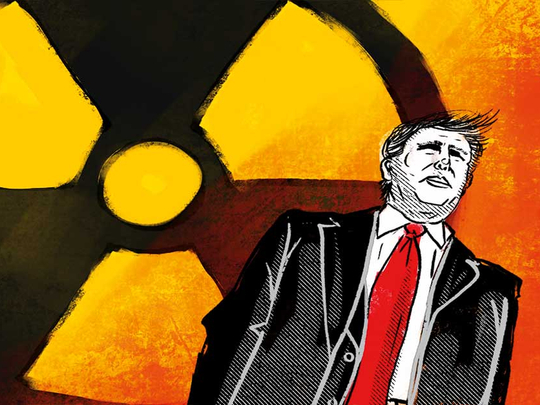
The debate over the Iranian nuclear deal has so far largely neglected a factor that potentially gives the United States leverage: The deteriorating economic situation in Iran. The Trump administration should integrate this factor into its strategy. Iran’s currency, the rial, has lost 25 per cent of its value against the dollar in the past several weeks. Two weeks ago, Tehran decided to set up an official exchange rate of 42,000 rials to the dollar, but that move is unlikely to succeed, given that the market prices the rial at 60,000 to the dollar (Dh3.67), some 43 per cent less. Inflation is also very high.
Iranians are also struggling to contend with a severe credit crisis; several financial institutions have gone bankrupt, depriving depositors of their savings. Iranian expatriates brought a considerable amount of capital back into the country after the nuclear deal’s signing, but that sense of initial optimism has long since dissipated (along with those funds). The current economic situation, combined with uncertainty about the future, are leading to capital flight, a decline in investment and high unemployment. The International Monetary Fund expects joblessness to remain above 11 per cent.
Two problems are driving economic decline. First, mismanagement and corruption are widespread. Iran’s Revolutionary Guard Corps dominates key industries and businesses, and it is notoriously inefficient. Of the billions that Iran received from the easing of sanctions following the nuclear agreement, substantial amounts were pocketed by the Revolutionary Guard or siphoned off to its bank accounts abroad.
Second, the economy must also contend with the opportunity costs of Iranian money squandered by the regime in exporting its revolution and supporting proxies such as Syrian President Bashar Al Assad. The Donald Trump administration’s new sanctions and the threat to scuttle the nuclear deal have also contributed to economic woes. Trump’s scepticism about the deal is discouraging foreign investment from Iran and fuelling uncertainty.
Europe is unlikely to support reinstatement of the full suite of economic sanctions imposed on Iran before the deal. Nevertheless, even unilateral sanctions by the United States would have crippling effects on the Iranian economy, which could descend into a state of stagflation.
The current poor economic outlook is producing instability. Reformers outside the government are losing hope in evolutionary change. Moderates in government have failed to offer meaningful reform. The Iranian people have largely lost confidence in Tehran’s ability to address economic problems. This is feeding widespread hostility to the religious authorities, to the extent that people are unafraid to insult them on the street.
Even though the chance of instability is high, the Supreme Leader Ayatollah Ali Khamenei has repeatedly demonstrated that he is willing to stay in control. As Iran’s economic crisis deepens, support among its core supporters in the Basij paramilitary group, particularly those from the Iran-Iraq war generation, may erode. Such a scenario could impact Tehran’s ability to suppress dissent through violence. Discontent has not reached a tipping point — but the possibility that it will is real.
The Trump administration could, of course, opt to maintain the nuclear deal. But that would forfeit the chance to capitalise on Iran’s crisis by threatening new US sanctions. A second option — extending uncertainty about the future of the agreement and the possibility of intensifying sanctions beyond the May deadline — could further exacerbate Iran’s internal woes and generate additional leverage. The Trump administration has already used the sceptre of uncertainty to devastating effect.
A third option — withdrawal from the nuclear deal — would give the US a big opportunity to impose costs on Iran. To have the greatest impact, withdrawal would have to be part of a comprehensive strategy to contain and roll back Iran. The strategy could include harsh financial sanctions, including restricting the use of the SWIFT system for transactions. It might include helping establish and maintain a balance of power between Tehran and its Arab neighbours, effective ideological pressure that builds on Tehran. Regionally, the strategy must include support for groups resisting Iranian hegemony and pushing back against Iran in both Iraq and Syria. And the US must maintain the posture that force will be used if Iran takes new steps toward acquiring nuclear weapons.
By applying such pressure, Washington might be able to force Iran to negotiate a better agreement. Iranian President Hassan Rouhani had said Tehran was merely weeks away from being unable to pay the salaries of government employees before the deal. A better nuclear agreement was possible in 2015 had the administration of former US president Barack Obama appreciated the leverage it had and used it. One can hope the US will not make the same mistake again.
— Washington Post
Zalmay Khalilzad was the US ambassador to the United Nations from 2007 to 2009.










